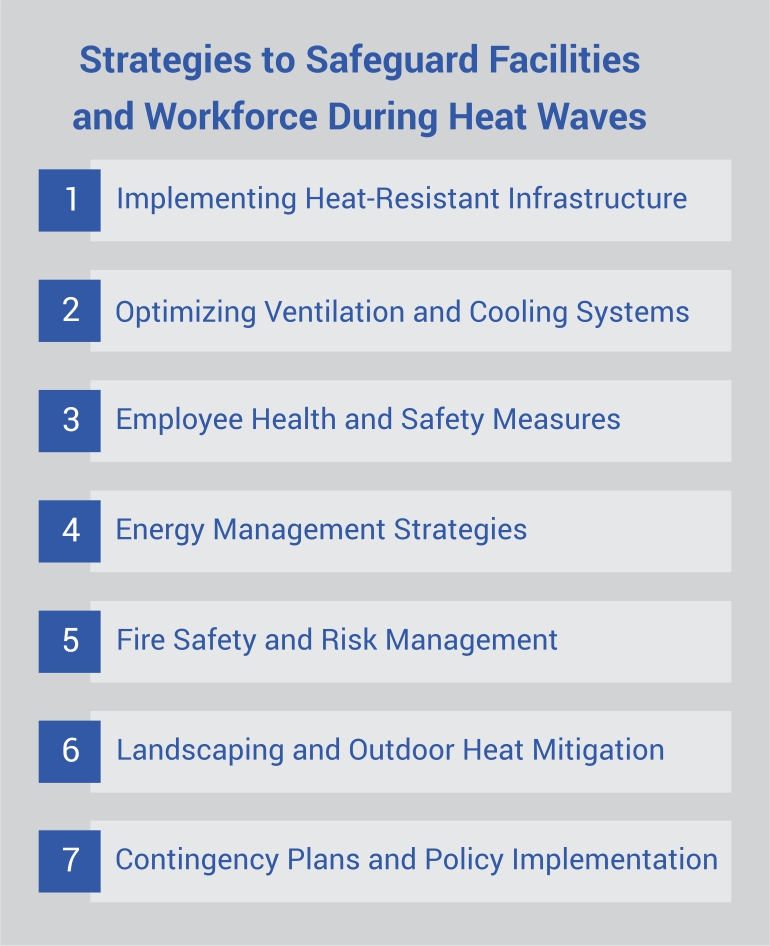Understanding the Heatwave Crisis in India
India has been grappling with intense heatwaves in recent years, with temperatures soaring above 45°C in several regions. The India Meteorological Department (IMD) issues heatwave alerts regularly, warning of extreme conditions that pose severe health and operational risks. Climate change, deforestation, and urbanization have exacerbated these heatwaves, making it imperative for businesses, industrial facilities, and workplaces to implement robust mitigation strategies.
A heatwave is not just a climate anomaly; it affects productivity, health, and infrastructure. Facilities that fail to prepare for extreme heat conditions risk operational disruptions, employee safety concerns, and higher maintenance costs. Therefore, proactive measures are essential to safeguard both infrastructure and the workforce.
Impact of Heatwaves on Facilities and Workforce
1. Employee Health and Safety Risks:
Prolonged exposure to extreme heat can cause heat-related illnesses such as heat exhaustion, heatstroke, dehydration, and respiratory issues. Workers, especially those involved in outdoor activities like construction, security, and maintenance, are highly vulnerable.
2. Increased Energy Consumption:
Air conditioning and cooling systems work overtime during heatwaves, leading to a surge in energy consumption. This results in higher electricity bills and potential strain on the power grid, causing outages and system failures.
3. Equipment and Machinery Malfunctions:
Industrial equipment, especially those operating at high temperatures, can overheat and malfunction. Heat-sensitive machinery may experience reduced efficiency, increased maintenance needs, or complete breakdowns.
4. Fire Hazards and Electrical Failures:
Extreme heat can exacerbate fire risks in facilities with combustible materials. Overheated electrical systems and transformers can also pose a fire hazard, leading to safety concerns and operational disruptions.
5. Impact on Productivity:
High temperatures lead to employee fatigue, reduced concentration, and lower productivity. Studies have shown that extreme heat negatively affects cognitive function, decision-making, and overall work efficiency.
Strategies to Safeguard Facilities and Workforce During Heatwaves

1. Implementing Heat-Resistant Infrastructure:
- Cool Roofing & Insulation: Install reflective roofing materials and insulation to reduce indoor temperatures.
- Green Walls & Rooftop Gardens: Planting trees and creating green spaces around facilities can lower ambient temperatures.
- Heat-Resistant Flooring & Windows: Using heat-resistant materials can help mitigate heat absorption and maintain cooler interiors.
2. Optimizing Ventilation and Cooling Systems:
- Ensure HVAC systems are well-maintained and operate efficiently.
- Install energy-efficient air conditioning and evaporative coolers in high-traffic areas.
- Promote natural ventilation by optimizing window placements and airflow.
3. Employee Health and Safety Measures:
- Hydration Stations: Ensure access to cool drinking water at multiple points within the facility.
- Flexible Work Schedules: Alter shift timings to avoid the peak afternoon heat.
- Rest Breaks & Cooling Zones: Designate shaded or air-conditioned rest areas for employees.
- Protective Clothing: Provide workers with lightweight, breathable uniforms and UV-protective gear.
- Heat Stress Training: Conduct awareness programs on recognizing and managing heat-related illnesses.
4. Energy Management Strategies:
- Use smart energy monitoring systems to optimize electricity consumption.
- Schedule non-essential machinery maintenance and operations during cooler hours.
- Install solar panels to reduce dependency on traditional power sources.
5. Fire Safety and Risk Management:
- Ensure fire extinguishers and hydrants are in working condition.
- Regularly inspect electrical wiring and transformers to prevent overheating.
- Establish emergency response protocols for fire and heat-related incidents.
6. Landscaping and Outdoor Heat Mitigation:
- Tree Plantation Drives: Increase greenery around facilities to provide natural shade.
- Permeable Pavements: Reduce heat absorption and improve groundwater recharge.
- Water Sprinkling Systems: Maintain humidity and cool down outdoor areas.
7. Contingency Plans and Policy Implementation:
- Develop heat emergency response plans that include evacuation procedures and first-aid measures.
- Establish policies on remote work options during extreme weather conditions.
- Implement insurance coverage for employees affected by heat-related illnesses.
Role of Facility Managers in Heatwave Preparedness
Facility managers play a crucial role in mitigating heatwave impacts by ensuring safety measures are in place. Key responsibilities include:
- Conducting regular heat audits to assess facility vulnerabilities.
- Implementing preventive facility maintenance for cooling systems and electrical equipment.
- Coordinating with local authorities and weather agencies for real-time alerts.
- Engaging with employees through awareness programs and training sessions.
Conclusion:
Heatwaves are becoming an unavoidable reality in India, and facilities must prioritize safeguarding their premises and workforce. By integrating heat-resistant infrastructure, optimizing cooling systems, ensuring worker safety, and implementing sustainable energy solutions, businesses can mitigate risks and maintain operational efficiency. Proactive measures not only protect employees but also contribute to long-term cost savings and sustainability. As climate conditions continue to change, facility management solutions must evolve to create resilient and heat-proof work environments.
By staying ahead of heatwave challenges, businesses can ensure safety, productivity, and operational continuity, even in the face of extreme weather events.
Industries we serve:
Automobile | Ancillary | Manufacturing | Pharmaceutical | Healthcare | Oil and Gas | FMCG | Education | Real Estate | Commercial
Also read: Measuring the ROI of Integrated Facility Management

